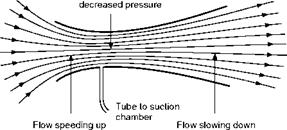The venturi tube
One of the most interesting examples of Bernoulli’s Theorem is provided by the venturi tube (Fig. 2.6). This simple but effective instrument is nothing but a tube which gradually narrows to a throat, and then expands even more gradually to the exit. Its effectiveness as a means of causing a decrease of pressure below that of the atmosphere depends very much on the exact shape.
If a photograph is taken, or a diagram made, of the flow of air or water through a venturi tube, it will be observed that the streamlines are closest together at the throat, and this gives an unfortunate impression that the fluid has been compressed at this point. Such an impression is the last thing we want to convey, and what we would like to be able to do is to show a video, or, better still, an actual experiment, which would make it quite clear that while it is true that the streamlines are closer together at the throat, the velocity of flow is also higher. This is the important point: the dynamic pressure has gone up and therefore, in accordance with Bernoulli’s principle, the static pressure has gone down. If a tube is taken from the throat and connected to a U-tube containing water, the suction will be clearly shown.
An interesting experiment with a venturi tube is to place an ordinary pitot tube (without a static) facing the airflow at various positions in the tube. Connect the pitot tube to a U-tube, and leave the other side of the U-tube open to the atmospheric pressure outside the air stream. The pitot tube will record P + їрУ[3], i. e. the static pressure in the stream plus the dynamic pressure, and the U-tube will therefore show the difference between this and the atmospheric pressure outside the stream. It will be found that p + ypV2 is very nearly constant, whether the pitot tube is placed in the free air stream in front of the venturi, or in the mouth, or the throat, or near the exit. This is a convincing proof of Bernoulli’s Theorem. The air speed increases from mouth to throat and then decreases again to the exit. The air speed increases very nearly in the same proportion as the area of cross-section of the venturi decreases, and this suggests that there is little or no change in the density of the air. Even more convincing evidence that the density does not change is provided by the flow of water through a venturi tube; the pattern of flow and the results obtained are very similar to those in air, and we know that water is for all practical purposes incompressible.
There are many practical examples of the venturi tube in everyday life, but there is no need to quote them, because we have sufficient examples in flying to illustrate this important principle. The choke tube in a carburettor is one; a wind tunnel is another, the experiments usually being done in the high-speed
|
High-speed flow
pressure decreasing pressure increasing |
Fig 2.6 Flow through venturi tube flow at the throat, and the air speed at this point is often measured by a single static hole in the side of the tunnel. A small venturi may be fitted inside a larger one, and the suction at the throat of the small venturi is then sufficient to drive gyroscopic instruments.












